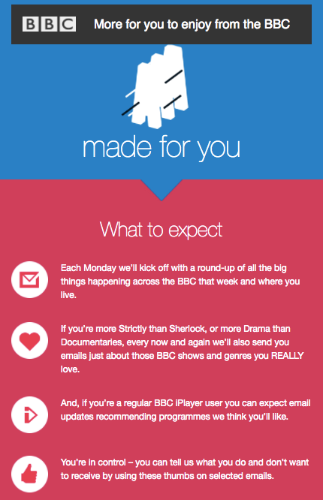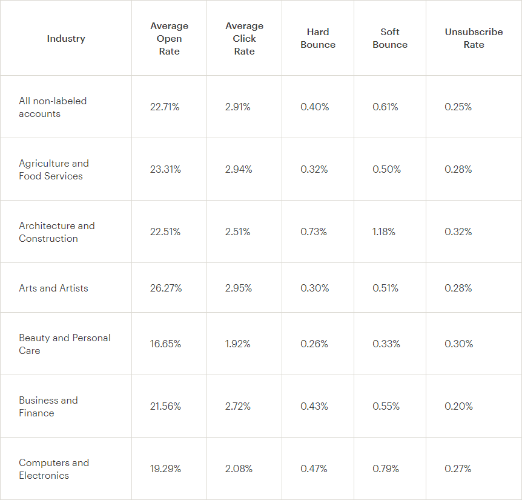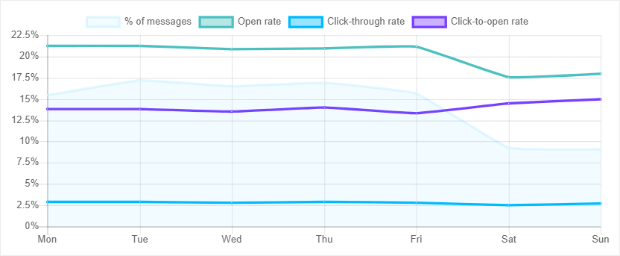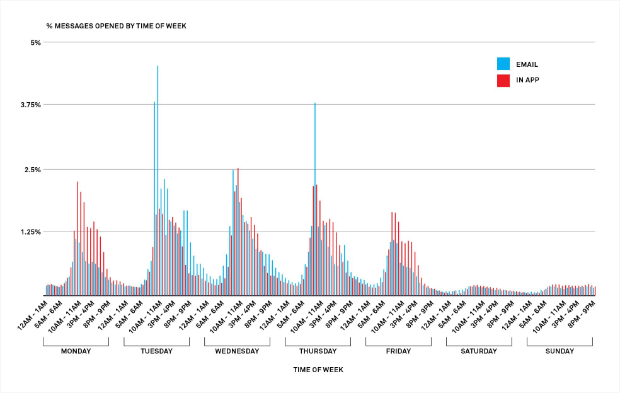SEO
Free SEO Analysis
SEO Services
Content Marketing Services
Local SEO
Link Building Services
Specialized SEO Services
PPC
REPUTATION MANAGEMENT
Free Reputation Management Analysis
Reputation Management Services
Review Management Services
Specialized Reputation Management Services
CEO Reputation Management
Brand Enhancement
Business and Directory Listings
Comprehensive Reputation Management Audit
SOCIAL MEDIA
Free Social Media Analysis
Specialized Social Services
WEB DEVELOPMENT
Free Website Analysis
Web Design Services
Mobile Development Services
Website Maintenance Services
Specialized Development Services
MARKETING AUTOMATION
Free Marketing Automation Analysis
Specialized Marketing Automation Services
Comprehensive Marketing Automation
INDUSTRIES
ABOUT DMA
Content Marketing, Marketing Automation
Email Marketing Frequency Best Practices for 2023
Request a quote
Its Fast, Easy & Free
Executive Summary
- Only half of the companies who use email marketing feel their email marketing efforts are poor to average
- It’s important to define your relationship at the outset. This means letting subscribers know right away if you’ll be sending weekly emails or if they should expect something monthly.
- Take a look at other companies in your industry. How often are they sending emails? What do the average open rates and click-through rates look like for your industry overall?
Email frequency can mean the difference between an engaged and active email list and one that continues to decline due to unsubscribes.
But what is a good email frequency? How can you choose an email frequency that works for everyone?
And where do you even begin?
In this article, we take an in-depth look at email frequency and share ten email frequency best practices that you can use to build your best email list.
Email Frequency Statistics
If you’re wondering about the best email frequency to keep your list engaged but not annoyed, email frequency statistics are a great place to start.
When you consider that the average U.S. worker will receive 126 emails every day, it’s easy to see how your marketing emails could get lost in the shuffle… Or, even worse, be an unwelcome addition to an already cluttered inbox.
And, since 87% of marketers use email to nurture their target audiences, it’s likely that your email will be competing against more than 100 others for a single shopper’s attention.
This is probably why only half of the companies who use email marketing feel their email marketing efforts are poor to average.
Think about that. Poor to average.
Fortunately, there are some easy things you can do to increase open rates and click-through rates and turn your email marketing campaigns into something your target audience even looks forward to getting.
Here are ten email marketing frequency best practices you can use to take your emails from a necessary evil to just necessary in the eyes of your target audience.
Email Marketing Frequency Best Practices
We’re focusing on email frequency best practices because it’s the number one question most digital marketers have: how often should I email my email list?
The real answer, of course, is it depends. Your audience is unique. Different even from your closest competitors.
Stop looking at your email list as a monolith instead of what it is: a group of people whose true commonality is that they’re interested in your company.
Sure, you can group them together in certain ways, but if you start viewing your email list as people instead of email addresses, that will come through in the way you craft your email copy.
And your subscribers will reward you with higher conversions.
So, treat your email list as real people. Check! But, there’s more you can do to keep your subscribers engaged.
Without further ado, let’s get into our email frequency best practices.
1. Let Subscribers Know What to Expect
From the very first email you send, you need to set expectations.
Your subscribers want to know what kind of content they’re going to be getting from you, and how often.
It’s important to define your relationship at the outset. This means letting subscribers know right away if you’ll be sending weekly emails or if they should expect something monthly.
Will you be sending them email updates about your product or deals only available to your subscribers?
BBC’s welcome email is an excellent example of how to go about setting expectations:

It breaks down how many emails subscribers can expect to receive and why they’d be getting those emails in the first place.
Then, BBC does something amazing.
They give their subscribers the power to turn off certain subscriptions just by clicking on a thumbs-up or thumbs-down button.
We’ll talk more about putting your subscribers in the driver seat for email frequency in a bit.
For now, remember this gem when you’re ready to write (or rewrite!) your welcome email series.
2. Be Consistent and On-Time
The purpose of email marketing is to nurture relationships with your subscribers, right?
That means sending regular, consistent emails and meeting the expectations you set in your welcome email.
Think about the BBC welcome email again.
BBC tells subscribers that “every Monday” they’ll be getting a weekly roundup email of the big things that happened on BBC that week.
If BBC then only sends those emails once in a while, or on a different day, their credibility is ruined in the minds of their subscribers.
If your company can’t follow through on something as basic as an email, your subscribers may wonder if they can trust you about other things.
Stick to the schedule you promised.
3. Automate Your Email Campaigns
An easy way to stick to whatever email frequency you told subscribers to expect is through email marketing automation.
When choosing an email marketing service, be sure to check out its marketing automation features. Any of the big name email marketing services like Constant Contact, Drip, ConvertKit, Sendinblue, and others should have email marketing automation built right in.
Email drip campaigns can help you automate follow-ups, nurture leads, and improve communications. Here are just a few things you can do with email marketing automation:
Send a certain campaign depending on subscriber actions
Add pretty amazing personalization
Edit existing campaigns based on real-time feedback
Automating your email campaigns can help you maintain a consistent email frequency and meet subscriber expectations.
Plus, it can save you a ton of time for things like welcome email series, promotional emails, and even sharing updates from your blog.
4. Look to Industry Peers
All industries are different. The right email frequency for business services could be entirely different for retail or nonprofit.
Take a look at other companies in your industry. How often are they sending emails? What do the average open rates and click-through rates look like for your industry overall?
Your email marketing service is a great resource for statistics like open rate, unsubscribe rate, and bounce rate, and more.
Here’s an example from Mailchimp:

Based on statistics from their users, Mailchimp reports overall open rates of 21.33%, but if you look at the excerpt above, you’ll see that not all industries hit that mark, while some surpass it.
Beauty and Personal Care, for example, fall well short of the average with an open rate of just 16.65%.
Use these statistics as a guide for your own analysis.
Pro Tip: If you’re looking for industry experts to guide your digital marketing efforts, look no further than Digital Marketing Agency. From B2B to venture capital, we handle it all.
5. Ask Your Subscribers
It’s never a bad idea to just ask when you don’t know the answer.
If you want to know how often subscribers want to hear from you, just send them a survey.
You can even use your email marketing service to segment users based on how often they want to receive emails from you.
6. Set Up an Email Preference Center
An email preference center is a great way to increase subscriber satisfaction. It puts subscribers in control of email frequency and helps you tailor your contact to them.
When you consider that about 70% of subscribers will unsubscribe because they’re tired of getting emails from you, it just makes sense to give subscribers the option to change their email frequency instead of unsubscribing altogether.
7. A/B Test to Find the Right Email Frequency
Remember a long time ago when we suggested looking at your industry averages to guide your own analysis?
The operative word is “guide.”
You don’t ever want to do something just because that’s how everyone else in your industry is doing it. That is a surefire way to lose tons of subscribers (and, by extension, sales).
Instead, use industry standards to build your own hypotheses about your email list.
Then, test those hypotheses using A/B split testing.
Split testing can be scary.
If you’ve already started sending out emails, making changes to email frequency is a risk.
Here are some things that might happen, so you can be prepared:
Engagement Drops
According to data from Return Path, decreasing email frequency and sending too few emails could result in your audience disengaging. This could lead to missed revenue opportunities, decreased lifetime value, inconsistent sender reputation, and more.
Unsubscribes Increase
Increasing email frequency, on the other hand, could bring an increase to unsubscribes or even spam reports.
Nothing
It’s possible that you can make changes to your email frequency and absolutely nothing changes.
But that doesn’t mean everything is perfect. It just means you need to test more. And perhaps test something else.
8. Send Better Content
Consider this: regardless of email frequency, more than 40% of email subscribers will unsubscribe because your content is no longer relevant to them.
To combat this, we recommend basing your email frequency around quality, not quantity.
Send a combination of educational and promotional emails to your email list using a consistent email frequency. Keep the content engaging and valuable to your subscribers by including discounts and freebies.
And, ask them what they want to get from you.
9. Find the Best Time to Send Emails
Sometimes the timing just isn’t right and it has nothing to do with your email frequency.
While we recommend an email frequency of once each week, it’s important to remember that all days of the week aren’t created equal when it comes to email marketing.
In a study by GetResponse, they analyzed about 4 billion emails sent by their customers between January and June 2019 (active senders with a minimum of 1,000 contacts), to get information on the best time to send to individual email addresses in their local time zones.
Here’s what they found out about the best day to send emails:

As you can see, Tuesday has the highest open rate and click-through rate, but just barely. What’s most obvious is that weekends are not a great option for sending marketing emails.
As for time of day, live chat software Intercom found that the best time to send emails is between 10 am and 2 pm.

Again, these are just guides to get you started. You should check your email marketing reports to see what days and times are most effective for your email list.
10. Segment Your Email List Based on Engagement
It’s unlikely that a single email frequency will work for your entire email list. That’s why segmenting your email list is so important.
The more you segment your email list, the better you can respond to your subscribers’ pain points.
When we started this article, we talked about the importance of treating your email list like people, not email addresses. Segmenting your email list can help with that.
Impact of Email Frequency
Email frequency can have an enormous impact on your email marketing efforts, affecting everything from open rates to conversion rates.
Open Rates
An open rate is the ratio of opened emails compared to the number of emails sent. Email frequency impacts your open rates first.
But, why?
The commonly held belief is that a higher email frequency can cause subscribers to see your email content as less valuable.
It’s sort of like supply and demand in economics. When your emails are frequent the supply is high and demand declines.
And, just like economics, you need to find a balance to your email frequency. You can use industry standards as a starting point.
Click-through Rates
Click-through rate is the ratio of people who have clicked on your email campaign compared to the number of emails you have sent.
Email frequency has a big impact on click-through rates. According to research by GetResponse, the more email newsletters sent during the week, the lower the click-through rate.
We recommend starting with an average click-through rate goal of 2.5%, depending on your industry benchmarks.
Conversion Rates
Your conversion rate is the percentage of subscribers who complete the action you want them to. For eCommerce, that action is more often than not a purchase, which means that conversion rates directly impact your bottom line.
Unsubscribe Rates
The unsubscribe rate represents the ratio of people who unsubscribe compared to the number of people who received or opened your email.
Aim for an unsubscribe rate of less than 0.5%.
Find Your Best Email Frequency
The best way to find the right email frequency for your audience is to ask them how often they want to hear from you. Then, segment them by email frequency.
This might mean that you create another email automation or two, but the end result will be a list that is healthier, happier, and engaged with your business and your product.
Our Sales team